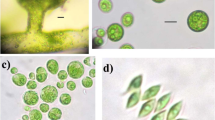Abstract
The properties of polyphenol extracts from marine brown algae of the families Laminariaceae, Alariaceae, Arthrothamnaceae, Costariaceae, Сystoseiraceae, and Fucaceae were studied. The release of polyphenols from algae was determined by the species affiliation and depended on the nature of the extractant. According to the content of total polyphenols and antioxidant activity, the maximum effect was observed in the ethanol extracts from algae of the genera Agarum, Thalassiophyllum, Fucus, Stephanocystis, and Arthrothamnus. Aqueous extracts from algae of the genera Saccharina, Alaria, and Costaria, were highly effective. The greatest yield of total polyphenols with high antioxidant activity (including that of phlorotannins) was found in Agarum turneri extracts. Fucus evanescens, Thalassiophyllum clathrus, and Stephanocystis crassipes can also be considered as promising sources of polyphenols with high antioxidant activity. Among aqueous extracts, high antioxidant activity was also found in the Costaria costata extract.




Similar content being viewed by others
REFERENCES
Aminina, N.M., Vishnevskaya, T.I., Karaulova, E.P., and Yakush, E.V., Content of polyphenols and antioxidant activity of extracts from certain species of seaweeds, Izv. Tikhookean. Nauchno-Issled.Inst. Rybn. Khoz. Okeanogr., 2017, vol. 189, pp. 184–191.
Bogolitsyn, K.G., Druzhinina, A.S., Ovchinnikov, D.V., et al., Polyphenols of brown algae, Khim. Rastit. Syr’ya, 2018, no. 3, pp. 5–21.
Imbs, T.I. and Zvyagintseva, T.N., Phlorotannins are polyphenolic metabolites of brown algae, Russ. J. Mar. Biol., 2018, vol. 44, no. 4, pp. 263–273.
Klindukh, M.P. and Obluchinskaya, E.D., A comparative study of the chemical composition of the brown algae Fucus vesiculosus and Ascophyllum nodosum,Vestn. Murm. Gos. Tekh. Univ., 2013, vol. 16, no. 3, pp. 466–471.
Sprygin, V.G., Kushnerova, N.F., Fomenko, S.E., et al., Marine algae: a promising source of polyphenolic antioxidants and essential phospholipid complexes, Izv. Samar. Nauchn. Tsentra, Ross. Akad. Nauk, 2012, vol. 14, no. 1(9), pp. 2299–2302.
Sprygin, V.G., Kushnerova, N.F., Fomenko, S.E., et al., The hepatoprotective properties of an extract from the brown alga Saccharina japonica,Russ. J. Mar. Biol., 2013, vol. 39, no. 1, pp. 65–69.
Sprygin, V.G., Kushnerova, N.F., Fomenko, S.E., et al., The influence of an extract from the marine brown alga Sargassum pallidum on the metabolic reactions in the liver under experimental toxic hepatitis, Russ. J. Mar. Biol., 2017, vol. 43, no. 6, pp. 479–484.
Artan, M., Li, Y., Karadeniz, F., et al., Anti-HIV-1 activity of phloroglucinol derivative, 6,6ʹ-bieckol, from Ecklonia cava,Bioorg. Med. Chem., 2008, vol. 16, pp. 7921–7926.
Cérantola, S., Breton, F., Gall, E.A., and Deslandes, E., Co-occurrence and antioxidant activities of fucol and fucophlorethol classes of polymeric phenols in Fucus spiralis,Bot. Mar., 2006, vol. 49, pp. 347–351.
Chkhikvishvili, I.D. and Ramazanov, Z.M., Phenolic substances of brown algae and their antioxidant activity, Appl. Biochem. Microbiol., 2000, vol. 36, no. 3, pp. 289–291.
Koivikko, R., Loponen, J., Honkanen, T., and Jomalainen, V., Contents of soluble, cell-wall-bound and exuded phlorotannins in the brown alga Fucus vesiculosus, with implications on their ecological functions, J. Chem. Ecol., 2005, vol. 31, no. 1, pp. 195–212.
Korczyński, M., Witkowska, Z., Opalińki, S., et al., Algae extract as a potential feed additive, in Marine Algae Extracts: Processes, Products, and Applications, Weinheim, Germany: Wiley-VCH, 2015, pp. 614–615.
Li, Y., Qian, Z.-J., Ryu, B., et al., Chemical components and its antioxidant properties in vitro: An edible marine brown alga, Ecklonia cava,Bioorg. Med. Chem., 2009, vol. 17, pp. 1963–1973.
Machu, L., Misurcova, L., Ambrozova, J.V., et al., Phenolic content and antioxidant capacity in algal food products, Molecules, 2015, vol. 20, no. 1, pp. 1118–1133.
Molyneux, P., The use of the stable free radical diphenylpicrylhydrazyl (DPPH) for estimating antioxidant activity, Songklanakarin J. Sci. Technol., 2004, vol. 26, no. 2, pp. 211–219.
Nguyen, P.H., Choi, I.-W., Kim, S.-K., and Jung, W.-K., Immune regulatory effects of phlorotannins derived from marine brown algae (Phaeophyta), in Handbook of Marine Macroalgae: Biotechnology and Applied Phycology, Chichester, U.K.: Wiley, 2011, pp. 340–343.
Shibata, T., Kawaguchi, S., Hama, Y., et al., Local and chemical distribution of phlorotannins in brown algae, J. Appl. Phycol., 2004, vol. 16, pp. 291–296.
Singh, I.P. and Bharate, S.B., Phloroglucinol compounds of natural origin, Nat. Prod. Rep., 2006, vol. 23, pp. 558–591.
Spurr, H.I., Extraction, separation and purification of polyphenols, polysaccharides and pigments from British seaweed for high-value applications, PhD Thesis, Univ. of Leeds, 2014, pp. 1–224.
Stern, J.L., Hagerman, A.E., Steinberg, P.D., and Mason, P.K., Phlorotannin-protein interactions, J. Chem. Ecol., 1996, vol. 22, pp. 1877–1899.
Waterman, P.G. and Mole, S., Analysis of Phenolic Plant Metabolites, Methods in Ecology, London: Blackwell, 1994.
Wissam, Z., Ghada, B., Wassim, A., and Warid, K., Effective extraction of polyphenols and proanthocyanidins from pomegranate’s peel, Int. J. Pharm. Pharm. Sci., 2012, vol. 4, suppl. 3, pp. 675–682.
Yuan, Y.V., Antioxidants from edible seaweeds, ACS Symp. Ser., 2007, vol. 956, pp. 268–301.
Funding
This research was carried out within the framework of the thematic calendar plan of the TINRO-Center for the 2018 year Implementation of State Monitoring of Aquatic Biological Resources of the Russian Federation (Inland Waters, Territorial Sea, Continental Shelf, Exclusive Economic Zone, the Sea of Azov, and the Caspian Sea).
Author information
Authors and Affiliations
Corresponding author
Ethics declarations
The authors declare that they have no conflict of interest. This article does not contain any studies involving animals or human participants performed by any of the authors.
Additional information
Translated by T. Koznova
Rights and permissions
About this article
Cite this article
Aminina, N.M., Vishnevskaya, T.I., Karaulova, E.P. et al. Prospects for the Use of Commercial and Potentially Commercial Brown Algae of the Far Eastern Seas as a Source of Polyphenols. Russ J Mar Biol 46, 34–41 (2020). https://doi.org/10.1134/S1063074020010022
Received:
Revised:
Accepted:
Published:
Issue Date:
DOI: https://doi.org/10.1134/S1063074020010022




